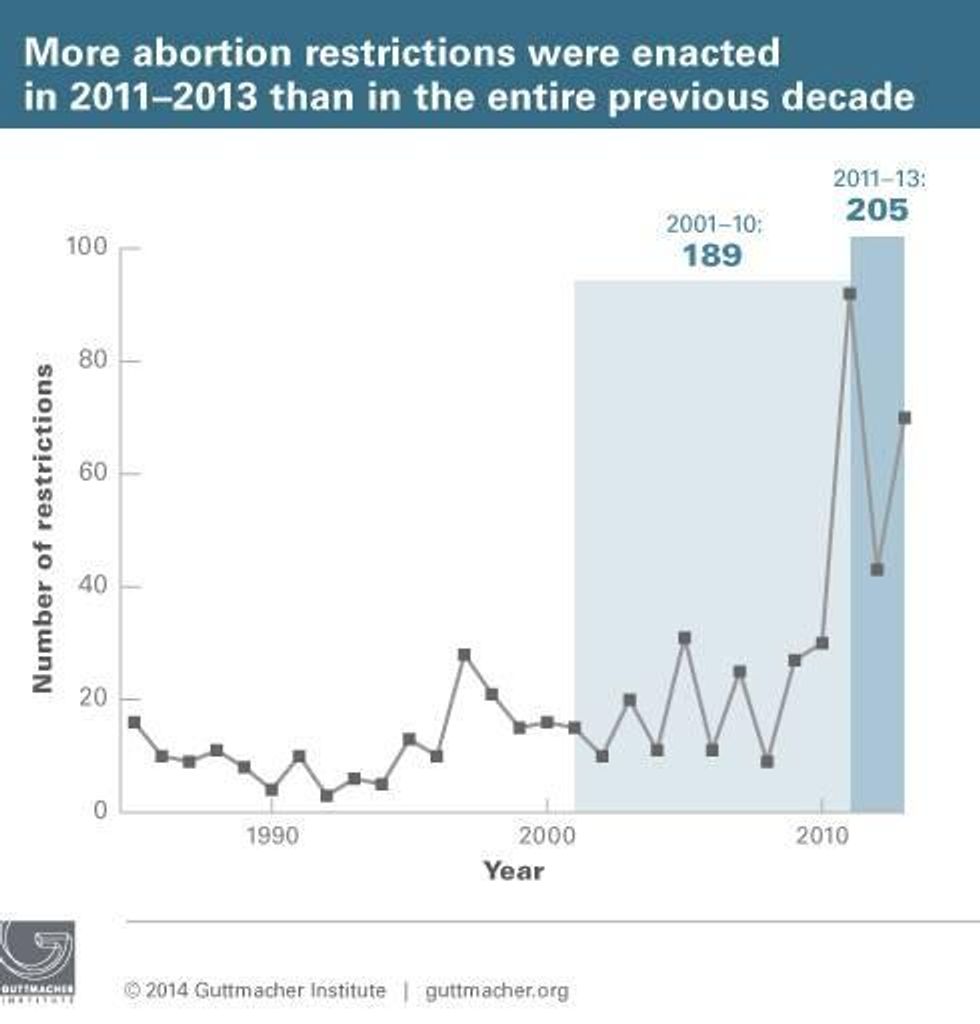2013: A Year of War on Reproductive Rights
New study finds drastic erosion of abortion rights and access, with 22 states implementing 70 restrictions on abortion

Over the past three years, state-level legislative initiatives have eroded access to abortion and shuttered clinics at a stunning pace. A new study from the pro-choice Guttmacher Institute finds that, in 2013, this trend accelerated and spread, drastically transforming the reproductive rights landscape across the country and entering the new year with considerable momentum.
The report, which was released this week, finds that in 2013, 22 states implemented 70 abortion restrictions. "This makes 2013 second only to 2011 in the number of new abortion restrictions enacted in a single year," the report reads.
Yet, when considered over a longer time frame, this trend is even more extreme. The report explains, "To put recent trends in even sharper relief, 205 abortion restrictions were enacted over the past three years (2011-2013), but just 189 were enacted during the entire previous decade (2001-2010)."
A majority of the restrictions fall under four categories: "abortion bans, restrictions on abortion providers, limitations on the provision of medication abortion and restrictions on coverage of abortion in private health plans," explains the report.
The net effect is transforming reproductive rights and access across the United States. "In 2000, 31% of women of reproductive age lived in one of the 13 states considered hostile to abortion [defined as having at least four major abortion restrictions], but by 2013, 56% of women lived in one of the now 27 hostile states."
The following chart illustrates this trajectory.

The report notes that not all state-level initiatives have curbed reproductive rights. A handful of states passed laws aimed at expanding access to reproductive and sexual health services, including a California law aimed at gradually expanding access to abortion. Yet, this trend is a pittance compared to the nation-wide attack on reproductive rights, the report finds.
"This is still spreading across the country," said Elizabeth Nash, state issues manager for the Guttmacher Institute, in an interview with The Huffington Post. "We've seen a shift from 2011 when much of [the] action took place in Kansas, Arizona and Oklahoma. We're now seeing Texas, Arkansas, North Carolina -- more states are adopting more restrictions."
_____________________
An Urgent Message From Our Co-Founder
Dear Common Dreams reader, The U.S. is on a fast track to authoritarianism like nothing I've ever seen. Meanwhile, corporate news outlets are utterly capitulating to Trump, twisting their coverage to avoid drawing his ire while lining up to stuff cash in his pockets. That's why I believe that Common Dreams is doing the best and most consequential reporting that we've ever done. Our small but mighty team is a progressive reporting powerhouse, covering the news every day that the corporate media never will. Our mission has always been simple: To inform. To inspire. And to ignite change for the common good. Now here's the key piece that I want all our readers to understand: None of this would be possible without your financial support. That's not just some fundraising cliche. It's the absolute and literal truth. We don't accept corporate advertising and never will. We don't have a paywall because we don't think people should be blocked from critical news based on their ability to pay. Everything we do is funded by the donations of readers like you. Will you donate now to help power the nonprofit, independent reporting of Common Dreams? Thank you for being a vital member of our community. Together, we can keep independent journalism alive when it’s needed most. - Craig Brown, Co-founder |

Over the past three years, state-level legislative initiatives have eroded access to abortion and shuttered clinics at a stunning pace. A new study from the pro-choice Guttmacher Institute finds that, in 2013, this trend accelerated and spread, drastically transforming the reproductive rights landscape across the country and entering the new year with considerable momentum.
The report, which was released this week, finds that in 2013, 22 states implemented 70 abortion restrictions. "This makes 2013 second only to 2011 in the number of new abortion restrictions enacted in a single year," the report reads.
Yet, when considered over a longer time frame, this trend is even more extreme. The report explains, "To put recent trends in even sharper relief, 205 abortion restrictions were enacted over the past three years (2011-2013), but just 189 were enacted during the entire previous decade (2001-2010)."
A majority of the restrictions fall under four categories: "abortion bans, restrictions on abortion providers, limitations on the provision of medication abortion and restrictions on coverage of abortion in private health plans," explains the report.
The net effect is transforming reproductive rights and access across the United States. "In 2000, 31% of women of reproductive age lived in one of the 13 states considered hostile to abortion [defined as having at least four major abortion restrictions], but by 2013, 56% of women lived in one of the now 27 hostile states."
The following chart illustrates this trajectory.

The report notes that not all state-level initiatives have curbed reproductive rights. A handful of states passed laws aimed at expanding access to reproductive and sexual health services, including a California law aimed at gradually expanding access to abortion. Yet, this trend is a pittance compared to the nation-wide attack on reproductive rights, the report finds.
"This is still spreading across the country," said Elizabeth Nash, state issues manager for the Guttmacher Institute, in an interview with The Huffington Post. "We've seen a shift from 2011 when much of [the] action took place in Kansas, Arizona and Oklahoma. We're now seeing Texas, Arkansas, North Carolina -- more states are adopting more restrictions."
_____________________

Over the past three years, state-level legislative initiatives have eroded access to abortion and shuttered clinics at a stunning pace. A new study from the pro-choice Guttmacher Institute finds that, in 2013, this trend accelerated and spread, drastically transforming the reproductive rights landscape across the country and entering the new year with considerable momentum.
The report, which was released this week, finds that in 2013, 22 states implemented 70 abortion restrictions. "This makes 2013 second only to 2011 in the number of new abortion restrictions enacted in a single year," the report reads.
Yet, when considered over a longer time frame, this trend is even more extreme. The report explains, "To put recent trends in even sharper relief, 205 abortion restrictions were enacted over the past three years (2011-2013), but just 189 were enacted during the entire previous decade (2001-2010)."
A majority of the restrictions fall under four categories: "abortion bans, restrictions on abortion providers, limitations on the provision of medication abortion and restrictions on coverage of abortion in private health plans," explains the report.
The net effect is transforming reproductive rights and access across the United States. "In 2000, 31% of women of reproductive age lived in one of the 13 states considered hostile to abortion [defined as having at least four major abortion restrictions], but by 2013, 56% of women lived in one of the now 27 hostile states."
The following chart illustrates this trajectory.

The report notes that not all state-level initiatives have curbed reproductive rights. A handful of states passed laws aimed at expanding access to reproductive and sexual health services, including a California law aimed at gradually expanding access to abortion. Yet, this trend is a pittance compared to the nation-wide attack on reproductive rights, the report finds.
"This is still spreading across the country," said Elizabeth Nash, state issues manager for the Guttmacher Institute, in an interview with The Huffington Post. "We've seen a shift from 2011 when much of [the] action took place in Kansas, Arizona and Oklahoma. We're now seeing Texas, Arkansas, North Carolina -- more states are adopting more restrictions."
_____________________

